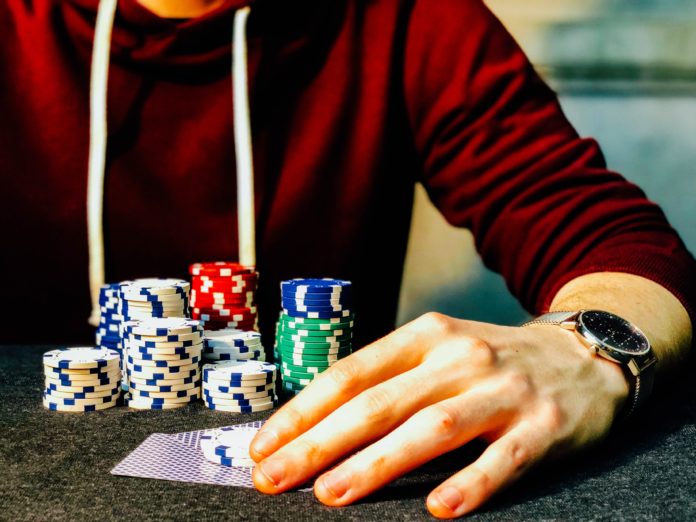Bankroll management is the most important skill to have when playing online poker. It allows the player to have a bankroll even through a down swing. This article is going to explain the basic skills of a bankroll management and how you can change it up depending on the type of poker tournament you’re playing.
What is bankroll management?
Bankroll management is managing your poker funds. You can’t just put your whole bankroll into one poker tournament and think everything is going to be ok. I know you thinking to yourself. If I lost, I could just make another deposit into my account and play another tournament.
How many times do you have to throw away money before you realize that you have to take into account the upswings, the downswings, and the time that goes into each tournament. Your bankroll is an investment into your poker play time. Winning is the only way to keep playing poker without going broke.
In order to give yourself the most amount of chances at winning the tournament you need to set the basic rules for yourself. In cash games the general rule is using 1% of your bankroll at the table so you have 100 chances at sitting at the table. when it comes to tournaments you want more than that. 150 to 300 buyins is the bankroll management standard for tournaments. This means if you only made a deposit of $300 into your account, you should be playing in $1.10 buyin poker tournaments.
Types Of Poker Tournaments
I do believe you have the option of setting different buyins for your bankroll management depending on the type of tournament you plan to put your focus on. The same way you would change your bankroll management for sports betting. I will cover the following tournament types; freezeout, rebuy, multi-buy, guaranteed, bounty, and satellites.
Freezeout Tournament
Freezeout tournament is your basic tournament. You buyin, get your chips, and play until you’re out of chips or won the tournament. For this type of tournament there aren’t any other factors to think about. You could be aggressive and stay with only 150 buyins or play it safe with 300 buyins.
Rebuy Tournament
Rebuy tournament allows you to buyin, get your chips, and give you a set amount of time to rebuy into the tournament if you lose your chips. At the end of the set time, you get one last chance to rebuy tto add to your stack of chips. For rebuy tournaments, I like to count each of them as 2 buyins. 1 buyin to get into the tournament and another buyin at the end of the rebuy phrase.
For example, if you have $2,000 playing $11 freezeout tournaments and you decide to play rebuy tournaments. I would move down to $5.50 rebuy tournaments to maintain the same rules set for your freezeout tournaments since we’re counting 2 buyins per 1 rebuy tournament.
Multi-entry Tournaments
Multi-entry tournaments are pretty interesting. They allow you to buy into the tournament multi times at the start of the tournament but unlike a rebuy tournament where you just playing one seat. A multi-entry tournament you buyin for more seats and play each seat like you’re playing multiple tables with cash games.
Just like the rebuy tournament, we have to count how many buyins we’re using for just 1 tournament to set the rules for the bankroll management. For example, if you have $2,000 in your account. You have to ask yourself how many buyins you want with the $2,000 and how many buyins per tournament. You could follow the same rules as the rebuy tournament and go with 2 buyins in $5.50 multi-entry tournaments or you could go down to $1.10 and have 5 buyins per tournament. Which would give you more chances at winning tournaments to grow your bankroll?
Guaranteed Tournament
Guaranteed Tournaments are tournaments with a guaranteed prize pool even if there aren’t enough buyins to cover the prize pool. Which means bigger payouts for a small player pool. However, these tournaments normally bring out a lot of players which means a much bigger prize pool than normal freezeout tournaments with a much bigger player pool.
I would set the same bankroll management rules for these tournaments as I do for the freezeout tournaments. 150 to 300 buyins should be more than enough to keep you playing poker without running out of money.
Bounty Tournament
Bounty tournaments are the most interesting tournaments to me because each buyin half goes to the prize pool and half is the bounty on the players head. You receive the bounty when you knockout of player from the tournament. You could very well make a profit from a bounty tournament without placing in a cash position.
If you was going to only focus on bounty tournaments you could go aggressive with 100 buyins and your safe point would be around 150 to 200 buyins. No need to super safe with 300 buyins for this type of tournament.
Satellite Tournament
Satellite tournaments are tournaments with a prize pool of entry tickets into a bigger buyin tournament and sometimes entry into a live tournament. For example, you could enter a $11 buyin tournament with the 1st place prize being an entry into a $109 buyin tournament. The chances of cashing in 2 tournaments in a row is slim but the payout is huge if you do. Which means you would want to have a much safer amount of buyins to go after these type of tournaments.
For example, using the same $2,000 from the examples above. You may want to focus on the $5.50 or $1.10 buyin satellite tournaments. This would give you over 300 buyins since you would have to play so many tournaments to cash from them.
How To Count Buyins For Bankroll
The easiest way to count the amount of buyins you have with your given bankroll is simple. Lets say you have $2,000 in your bankroll, you want to play the $5.50 buyin tournaments, and you want to know how many buyins you have for that buyin level. All you have to do is $2,000/$5.50 = 363 buyins. See, you have more than enough buyins for what you want to play.


